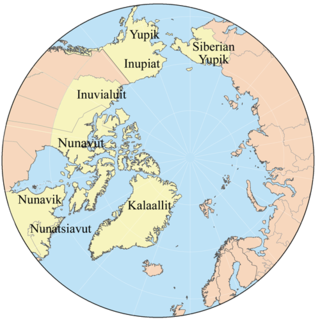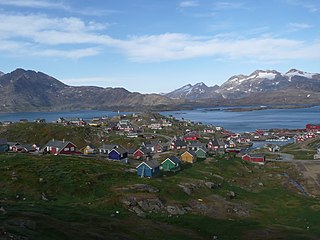Related Research Articles

Eskimo is an exonym used to refer to two closely related Indigenous peoples: the Inuit and the Yupik of eastern Siberia and Alaska. A related third group, the Aleut, which inhabit the Aleutian Islands, are generally excluded from the definition of Eskimo. The three groups share a relatively recent common ancestor, and speak related languages belonging to the Eskaleut language family.

Greenland is an island autonomous territory of Denmark in North America. It lies between the Arctic and Atlantic oceans, east of the Canadian Arctic Archipelago. Greenland is the world's largest island. It is one of three countries that form the Kingdom of Denmark, the others being Denmark and the Faroe Islands; the citizens of all three countries are citizens of Denmark and the European Union. The capital and largest city of Greenland is Nuuk.

This is a demography of the population of Greenland including population density, ethnicity, economic status, religious affiliations and other aspects of the population.

The Inuit languages are a closely related group of indigenous American languages traditionally spoken across the North American Arctic and the adjacent subarctic regions as far south as Labrador. The Inuit languages are one of the two branches of the Eskimoan language family, the other being the Yupik languages, which are spoken in Alaska and the Russian Far East. Most Inuit people live in one of three countries: Greenland, a self-governing territory within the Kingdom of Denmark; Canada, specifically in Nunavut, the Inuvialuit Settlement Region of the Northwest Territories, the Nunavik region of Quebec, and the Nunatsiavut and NunatuKavut regions of Labrador; and the United States, specifically in northern and western Alaska.
Mobilian Jargon was a pidgin used as a lingua franca among Native American groups living along the Gulf of Mexico around the time of European settlement of the region. It was the main language among Indian tribes in this area, mainly Louisiana. There is evidence indicating its existence as early as the late 17th to early 18th century. The Indian groups that are said to have used it were the Alabama, Apalachee, Biloxi, Chacato, Pakana, Pascagoula, Taensa, Tunica, Caddo, Chickasaw, Houma, Choctaw, Chitimacha, Natchez, and Ofo. The name is thought to refer to the Mobile Indians of the central Gulf Coast, but did not originate from this group; Mobilian Jargon is linguistically and grammatically different from the language traditionally spoken by the Mobile Indians.
A pidgin, or pidgin language, is a grammatically simplified means of communication that develops between two or more groups of people that do not have a language in common: typically, its vocabulary and grammar are limited and often drawn from several languages. It is most commonly employed in situations such as trade, or where both groups speak languages different from the language of the country in which they reside. Linguists do not typically consider pidgins as full or complete languages.

The history of Greenland is a history of life under extreme Arctic conditions: currently, an ice sheet covers about eighty percent of the island, restricting human activity largely to the coasts.

The music of Greenland is a mixture of two primary strands, Inuit and Danish, mixed with influences from the United States and United Kingdom.

Skræling is the name the Norse Greenlanders used for the peoples they encountered in North America. In surviving sources, it is first applied to the Thule people, the proto-Inuit group with whom the Norse coexisted in Greenland after about the 13th century. In the sagas, it is also used for the peoples of the region known as Vinland whom the Norse encountered and fought during their expeditions there in the early 11th century.

Greenlandic is an Eskimo–Aleut language with about 57,000 speakers, mostly Greenlandic Inuit in Greenland. It is closely related to the Inuit languages in Canada such as Inuktitut. It is the most widely spoken Eskimo–Aleut language. In June 2009, the government of Greenland, the Naalakkersuisut, made Greenlandic the sole official language of the autonomous territory, to strengthen it in the face of competition from the colonial language, Danish. The main variety is Kalaallisut, or West Greenlandic. The second variety is Tunumiit oraasiat, or East Greenlandic. The language of the Inughuit of Greenland, Inuktun or Polar Eskimo, is a recent arrival and a dialect of Inuktitut.
Language contact occurs when speakers of two or more languages or varieties interact and influence each other. The study of language contact is called contact linguistics. When speakers of different languages interact closely, it is typical for their languages to influence each other. Language contact can occur at language borders, between adstratum languages, or as the result of migration, with an intrusive language acting as either a superstratum or a substratum.

West Greenlandic, also known as Kalaallisut, is the primary language of Greenland and constitutes the Greenlandic language, spoken by the vast majority of the inhabitants of Greenland, as well as by thousands of Greenlandic Inuit in Denmark proper. It was historically spoken in the southwestern part of Greenland, i.e. the region around Nuuk.

Inuktun is the language of approximately 1,000 indigenous Inughuit, inhabiting the world's northernmost settlements in Qaanaaq and the surrounding villages in northwestern Greenland.

The Inughuit, or the Smith Sound Inuit, historically Arctic Highlanders or Polar Eskimos, are Greenlandic Inuit. They are the northernmost group of Inuit and the northernmost people in North America, living in Greenland. Inughuit make up about 1% of the population of Greenland.

Greenlandic Norse is an extinct North Germanic language that was spoken in the Norse settlements of Greenland until their demise in the late 15th century. The language is primarily attested by runic inscriptions found in Greenland. The limited inscriptional evidence shows some innovations, including the use of initial t for þ, but also the conservation of certain features that changed in other Norse languages. Some runic features are regarded as characteristically Greenlandic, and when they are sporadically found outside of Greenland, they may suggest travelling Greenlanders.

Inuit are a group of culturally similar indigenous peoples inhabiting the Arctic and subarctic regions of Greenland, Labrador, Quebec, Nunavut, the Northwest Territories, and Alaska. Inuit languages are part of the Eskimo–Aleut languages, also known as Inuit-Yupik-Unangan, and also as Eskaleut. Inuit Sign Language is a critically endangered language isolate used in Nunavut.

Greenlanders are people identified with Greenland or the indigenous people, the Greenlandic Inuit. This connection may be residential, legal, historical, or cultural. For most Greenlanders, many of these connections exist and are collectively the source of their being Greenlandic. However, the term can in different contexts be delimited more precisely in different ways: as the inhabitants of Greenland, as nationals of Greenland or more broadly as persons who feel a cultural affiliation in a broad sense to Greenland. More controversial is a more recent use of the word in the sense persons of Greenlandic origin, i.e. persons whose parents were born in Greenland.
This article discusses the phonology of the Inuit languages. Unless otherwise noted, statements refer to Inuktitut dialects of Canada.

Tunumiit or Iivit are Greenlandic Inuit from Tunu or Kangia, the eastern part of Greenland. The Tunumiit live now mainly in Tasiilaq and Ittoqqortoormiit and are a part of the Arctic people known collectively as the Inuit. The singular for Tunumiit is Tunumiu.
This article discusses the phonological system of the Greenlandic language.
References
- Marianne Mithun (2001) The Languages of Native North America, p 593ff
- Hein van der Voort, "Eskimo pidgin", in Arends, Muysken, & Smith (eds), 1995, Pidgins and Creoles: an introduction